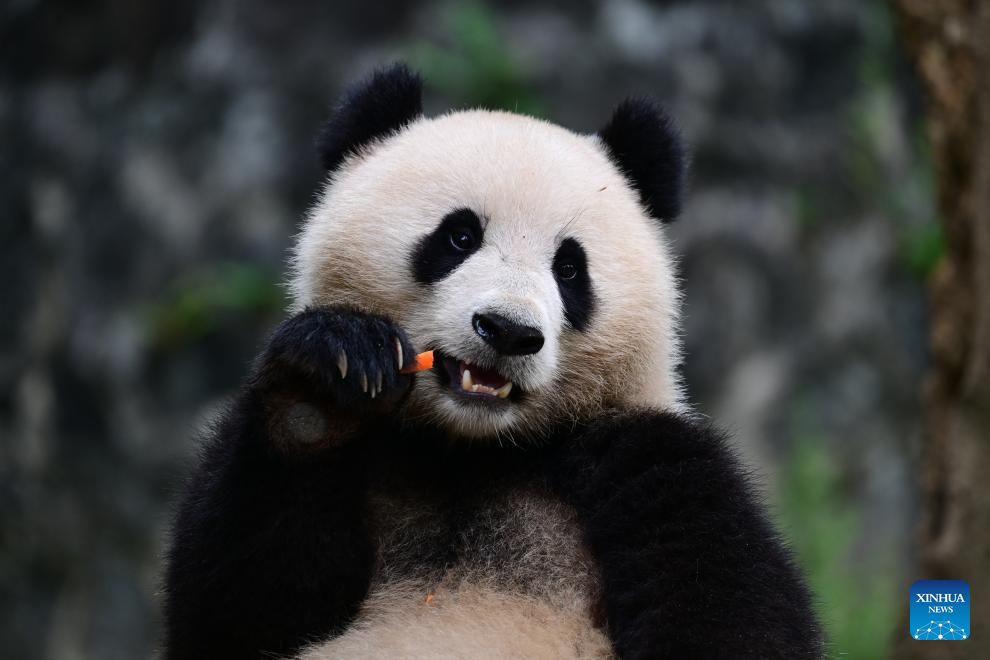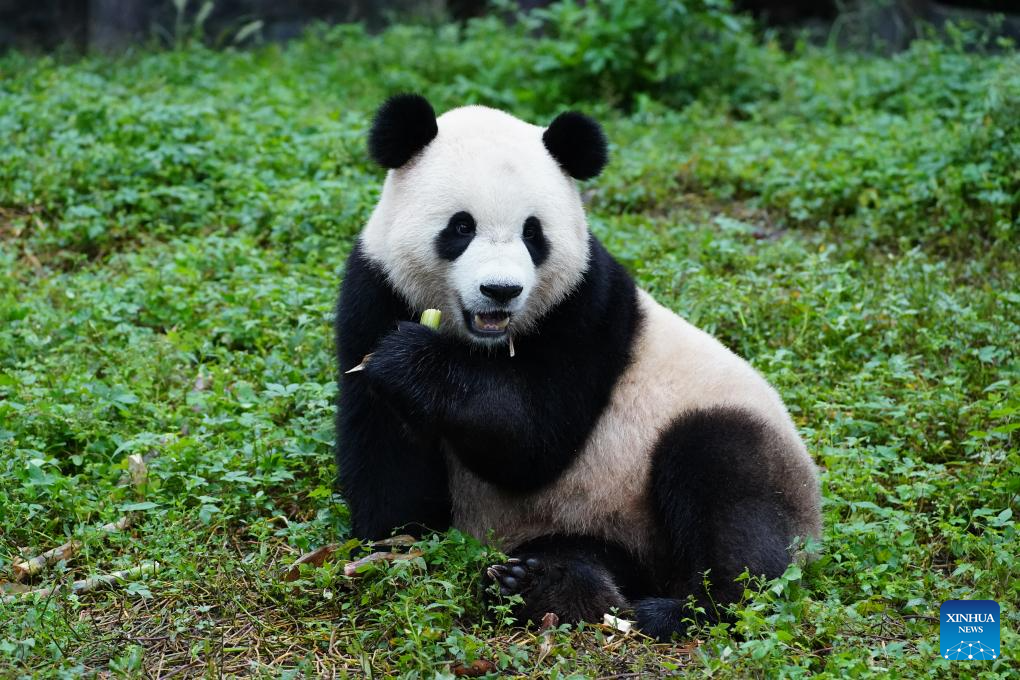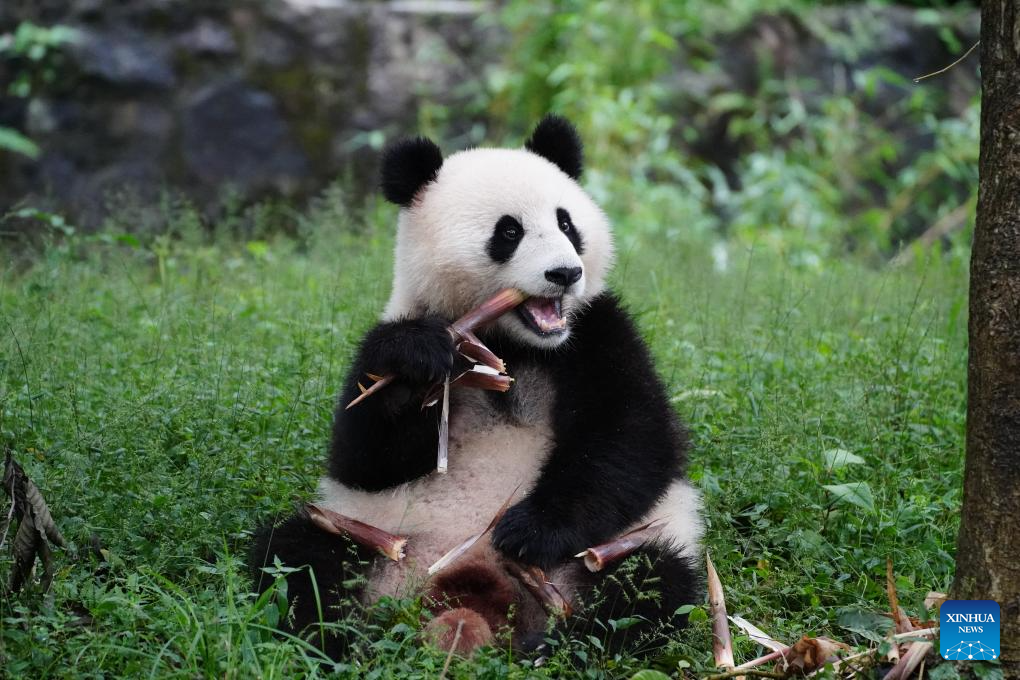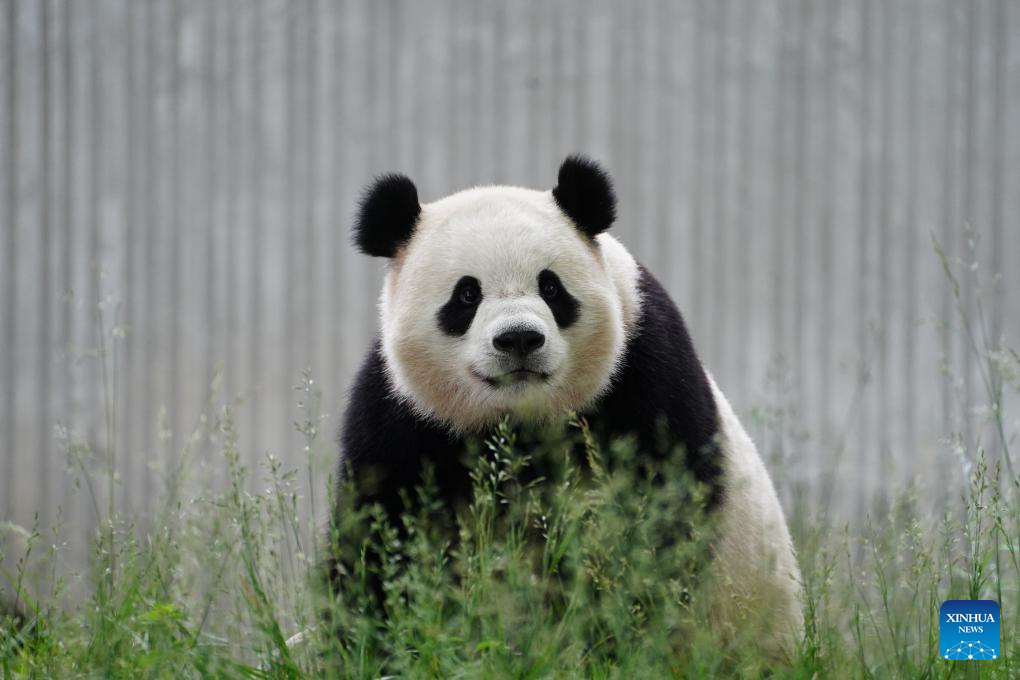
This photo taken on Aug. 7, 2024 shows giant panda Qing Bao (female) in Chengdu, southwest China's Sichuan Province. In the early hours of Oct. 15, 2024, a pair of giant pandas, three-year-old pandas Bao Li (male) and Qing Bao (female), departed from southwest China's Sichuan Province and headed to the United States to make their new home at the Smithsonian's National Zoo in Washington, D.C. This is the second time this year that China has sent giant pandas to the United States. (China Conservation and Research Center for the Giant Panda (CCRCGP)/Handout via Xinhua)
CHENGDU, Oct. 15 (Xinhua) -- In the early hours of Tuesday, a pair of giant pandas departed from southwest China and headed to the United States to make their new home at the Smithsonian's National Zoo in Washington, D.C.
This is the second time this year that China has sent giant pandas to the United States.
Sent as part of a 10-year international giant panda protection cooperation program, three-year-old pandas Bao Li (male) and Qing Bao (female) left their hometown in Sichuan Province accompanied by an experienced breeder and a veterinarian to help them adapt quickly to their new environment at the American zoo, according to the China Conservation and Research Center for the Giant Panda (CCRCGP).
Food prepared for the trip includes steamed corn buns, bamboo shoots and carrots, as well as water and medicine.
The American zoo had also sent three keepers and veterinary experts to China to assist with the transport and accompany the bears, the China Wildlife Conservation Association said in an announcement.
"This historic moment is truly one to celebrate as we embark on the next chapter of our giant panda conservation program," said Brandie Smith, John and Adrienne Mars director of the Smithsonian's National Zoo and Conservation Biology Institute (NZCBI).
Lu Yongbin, secretary of the CCRCGP committee of the Communist Party of China, said at a farewell ceremony on Monday that the new round of China-U.S. cooperation will "boost bilateral collaboration in endangered species and biodiversity protection" and "enhance the friendship between the Chinese and American people."
Chinese social media users expressed their best wishes for the bears. "Qing Bao and Bao Li, eat well and enjoy your life there," posted a netizen on Chinese lifestyle-sharing platform Xiaohongshu.
"They are going there carrying the goodwill of the Chinese people," wrote another user.
Bao Li, whose name means "treasure" and "energy" in Mandarin, was born in August 2021. He shares a special bond with the Smithsonian's National Zoo, as he is the son of Bao Bao and the grandson of Tian Tian and Mei Xiang -- all former residents of the zoo.
Qing Bao, whose name means "green" and "treasure" in Mandarin, was born in September 2021.
To ensure that the two giant pandas live healthy and happy lives at the Smithsonian's National Zoo, experts from China have made multiple visits to assess their living environment, feeding management, food supply and healthcare, according to the National Forestry and Grassland Administration.
Based on the recommendations of Chinese experts, the American zoo has implemented a range of measures to prepare for the arrival of the pandas. These include upgrading their shelter, securing a stable supply of bamboo and bamboo shoots, and assembling a professional team to take care of them.
Per standard procedure, the pandas will be quarantined in the panda house for a minimum of 30 days upon arriving at the NZCBI, according to a previous news release.
After their quarantine, the bears will have a few more weeks to adjust to their new home. The public debut date will be announced once the animal care team determines they are ready to meet visitors, the NZCBI said.
Since the first pair arrived at the Smithsonian's National Zoo, also known as the U.S. National Zoo, in 1972, pandas have remained one of the biggest attractions there, drawing an estimated 1.9 million visitors annually, according to the NZCBI.
So far China has collaborated with 26 institutions across 20 countries to promote giant panda conservation.
In late June, Yun Chuan and Xin Bao, two pandas from Sichuan, headed to the San Diego Zoo in the United States, the first to enter the country in over two decades.
Wang Yiwei, a professor at the Renmin University of China, noted that pandas are loved by people across the world. "It reminds us that we, Chinese and Americans alike, are living on the same planet, and it is the collective responsibility of the entire humankind to preserve our ecosystem," he said.
"Friendship between China and the United States is rooted in the people," he added, expressing hope that the pandas could serve as ambassadors and boost friendship between the two sides. ■

Staff members transfer giant panda Qing Bao (female) for Chengdu Shuangliu International Airport in Chengdu, southwest China's Sichuan Province, Oct. 14, 2024. In the early hours of Oct. 15, 2024, a pair of giant pandas, three-year-old pandas Bao Li (male) and Qing Bao (female), departed from southwest China's Sichuan Province and headed to the United States to make their new home at the Smithsonian's National Zoo in Washington, D.C. This is the second time this year that China has sent giant pandas to the United States. (China Conservation and Research Center for the Giant Panda (CCRCGP)/Handout via Xinhua)

This photo taken on Sept. 30, 2024 shows giant panda Bao Li (male) in southwest China's Sichuan Province. In the early hours of Oct. 15, 2024, a pair of giant pandas, three-year-old pandas Bao Li (male) and Qing Bao (female), departed from southwest China's Sichuan Province and headed to the United States to make their new home at the Smithsonian's National Zoo in Washington, D.C. This is the second time this year that China has sent giant pandas to the United States. (China Conservation and Research Center for the Giant Panda (CCRCGP)/Handout via Xinhua)

Staff members bid farewell to the pair of giant pandas Bao Li (male) and Qing Bao (female) at the Dujiangyan base of the China Conservation and Research Center for the Giant Panda in Chengdu, southwest China's Sichuan Province, Oct. 14, 2024. In the early hours of Oct. 15, 2024, a pair of giant pandas, three-year-old pandas Bao Li (male) and Qing Bao (female), departed from southwest China's Sichuan Province and headed to the United States to make their new home at the Smithsonian's National Zoo in Washington, D.C. This is the second time this year that China has sent giant pandas to the United States. (China Conservation and Research Center for the Giant Panda (CCRCGP)/Handout via Xinhua)

This photo taken on Sept. 30, 2024 shows giant panda Qing Bao (female) in southwest China's Sichuan Province. In the early hours of Oct. 15, 2024, a pair of giant pandas, three-year-old pandas Bao Li (male) and Qing Bao (female), departed from southwest China's Sichuan Province and headed to the United States to make their new home at the Smithsonian's National Zoo in Washington, D.C. This is the second time this year that China has sent giant pandas to the United States. (China Conservation and Research Center for the Giant Panda (CCRCGP)/Handout via Xinhua)

This photo taken on June 6, 2024 shows giant panda Bao Li (male) in southwest China's Sichuan Province. In the early hours of Oct. 15, 2024, a pair of giant pandas, three-year-old pandas Bao Li (male) and Qing Bao (female), departed from southwest China's Sichuan Province and headed to the United States to make their new home at the Smithsonian's National Zoo in Washington, D.C. This is the second time this year that China has sent giant pandas to the United States. (China Conservation and Research Center for the Giant Panda (CCRCGP)/Handout via Xinhua)

Staff members transfer giant panda Bao Li (male) for Chengdu Shuangliu International Airport in Chengdu, southwest China's Sichuan Province, Oct. 14, 2024. In the early hours of Oct. 15, 2024, a pair of giant pandas, three-year-old pandas Bao Li (male) and Qing Bao (female), departed from southwest China's Sichuan Province and headed to the United States to make their new home at the Smithsonian's National Zoo in Washington, D.C. This is the second time this year that China has sent giant pandas to the United States. (China Conservation and Research Center for the Giant Panda (CCRCGP)/Handout via Xinhua)



